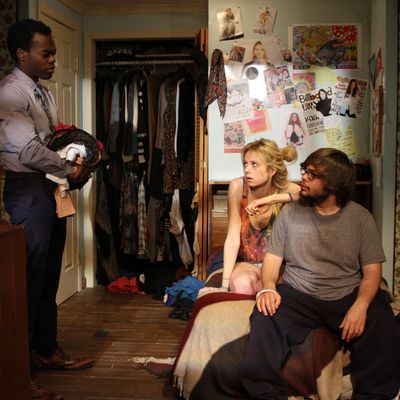
Especially after the loud uplift and confetti cannons of Broadway’s spring jamboree, one of the pleasures of Off Broadway in May is the chance to recalibrate your ears and expectations to a more human scale. Precision kicklines give way to the individual choices of actors working in the same room with you, inches away. Yes, it’s a blast watching drag queens do flips on conveyor belts, or Bette Midler crack wise in a caftan, but it’s also pretty thrilling to watch Deirdre O’Connell, as a beleaguered stepmother in A Family for All Occasions, walk into her home after a day at a factory and do nothing. She’s so stiff she can barely sit. Even the muscles around her mouth — which in the 90-seat Bank Street Theater you can easily see — are clenched. She’s the living embodiment of the word dour, down to the cellular level, it seems, and in the second act, when she tries out a three-speed electronic foot massager someone has brought as a gift, her pleasure is so surprising (and nearby) it makes you laugh as if it were happening to you.
Only terrifically detailed acting can offer such moments, and A Family for All Occasions, written by Bob Glaudini and directed by Philip Seymour Hoffman, is stuffed with them. But as with many productions of the Labyrinth Theater Company, which has made this sort of gimmick-free naturalism a hallmark, that turns out to be both a boon and a bore. A boon because you very quickly know, as if in your bones, exactly who the characters are. A bore because you never know anything else.
It’s not that there’s a lack of story. O’Connell’s character, May, is married to a retired electrician named Howard, whose first wife disappeared one night, leaving him with two young children to raise. Those children are now in their twenties: Sam, a slovenly self-proclaimed computer genius who is developing a game about evil babies that he hopes will earn him a full ride at MIT; and Sue, a furious nymphet on the verge of self-destruction. All four characters are changed by the arrival of the handsome and thoughtful young Oz, a Pinteresque intruder except for his complete lack of malice. He loves Sue, brings Sam a better computer, plays Scrabble with Howard, and even manages, with the help of the foot massager, to melt May’s glacial reserve. By the end, the family is reconfigured in ways that are both unlikely and completely unsurprising if you’ve seen this kind of play before, which you have.
As often happens in Theater of the Earnest, the flip side of the superbly detailed acting, for which Hoffman has to get some of the credit, is that broader matters are left unattended. Pacing, variety, motivation, and basic believability are left to fend for themselves. Most grievously, the story is shaped at every turn by dramaturgical rather than human need. It’s heartbreaking, for instance, to watch Jeffrey DeMunn, as Howard, try to chat up and discipline his disdainful children; I don’t think I’ve ever seen the delusional enthusiasm of disappointed parents portrayed so wrenchingly — except by Hoffman himself in Death of a Salesman. But why doesn’t Howard know what the audience has known about those kids (thanks to the expertly repulsive performances of Justine Lupe and Charlie Saxton) from their first appearance? Why do we understand, as Howard does not, that Oz is not all he seems? Is Howard not privy to William Jackson Harper’s instantly legible characterization? It’s a bad idea to let the audience get so far ahead of the script; doubt is not the same as mystery. And good actors actually make the problem worse. The better they inhabit the characters, the less you believe the play.
Off-Broadway used to be rife with this sort of drama, in which slow pacing was equated with naturalism and unrelieved unpleasantness was considered salutary, especially when experienced from no more than six rows away. That ethos has been disappearing for decades; with its underlined themes and flat ironies — “Stay on the sunny side,” Howard habitually calls out to May, despite her permafrown — A Family for All Occasions often feels like both a throwback and a tribute. Late in the play there’s even a scene in which Howard methodically repairs a lamp. Jeffrey DeMunn has clearly been given a lesson in wiring; by the end of the interminable passage, so have you. It makes you long for the unwholesome glibness of Broadway. Downtown, God may be in the details, but sometimes he gets lost there.
A Family for All Occasions is at the Bank Street Theater through May 26.




